There are no windows on the ground floor of R&D Cocktail Lab. The outside of the bar on 178 Yanji Street is a simple dark gray wall with the ethanol molecule carved in the right-hand corner. The molecule is also the only spot where curious passersby can sneak a peek.
Inside, medicine cabinets line the wall behind a narrow wooden bar. Displayed on the shelves are bourbons, bitters and a row of infusions with labels such as “black tea vodka” and “green tea gin.” On the wall are four characters: 詩朋酒侶 (shi peng jiu lu), which means to enjoy good alcohol with good friends.
Books about alcohol line the shelves on the upper level, which is more 1930s Shanghai than apothecary-esque. Old Chinese-style sliding doors portion off the room, and a partly shielded window with intricate engravings look out into a small balcony where fresh herbs such as rosemary and marigold are grown. In some ways, it’s easy to imagine the original set-up of the 80-year-old building, which was one of Taipei’s first lottery houses.
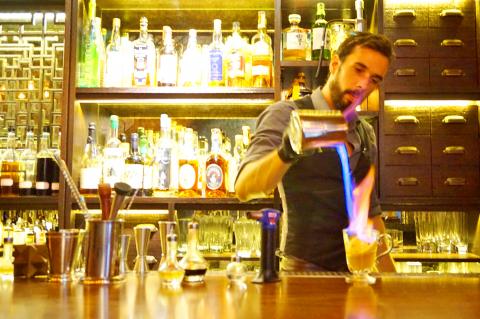
Photo: Dana Ter, Taipei Times
R&D, which stands for “Research & Development,” is the brainchild of three entrepreneurs united by their nerdy fascination with liquors — Spencer Huang (黃勝斌), who is half American and half Taiwanese, Yann Gueroult from France and Dale Kung (孔柏仁) from Taiwan. Kung was Huang’s language professor at National Taiwan University. Hungover from previous nights’ shenanigans, Huang would design his one-on-one classes with Kung in such a way that they were talking about alcohol each class. He eventually convinced Kung to leave his teaching position and join him and his friend Gueroult, who was a chef back in France, to open R&D in January this year.
Huang and Gueroult were bartenders at Ounce, another speakeasy-type bar, where Huang says they “became obsessed with infusions.” At R&D, like at Ounce, everything is “built to spec” which means there’s no menu. Customers simply tell the bartender the flavors they like, and he’ll whip up a cocktail using whatever fresh ingredients are available. But that’s where the similarities with Ounce and other craft cocktail bars end.
Gueroult says that there’s the assumption in Taiwan that if a bar is owned by expats, or even if it’s an upscale establishment, it has to have a Western theme.
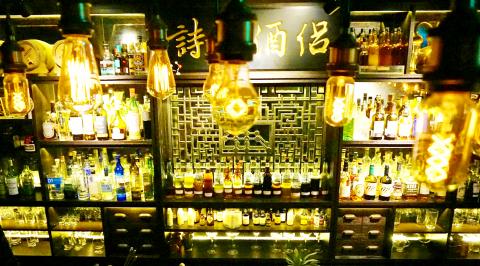
Photo: Dana Ter, Taipei Times
Huang thinks this is silly. “We’re white guys,” he says, referring to him and Gueroult. “So we decided to open an Asian-themed bar.”
Although many of the bitters and bourbons are collected from their travels around the world, the fruits, spices and herbs are locally sourced. Huang travels to Pingtung to buy fresh fruit from farmers, and his friends sometimes bring ingredients, such as lemon thyme, from their gardens to the bar. The ingredients available at the bar match the growing season, so while the summer months have seen more mango-rum infusions, drinks with strawberries and passion fruit will start popping up during the winter.
“There’s a lot of under-valued fresh ingredients in Taiwan,” Huang says.
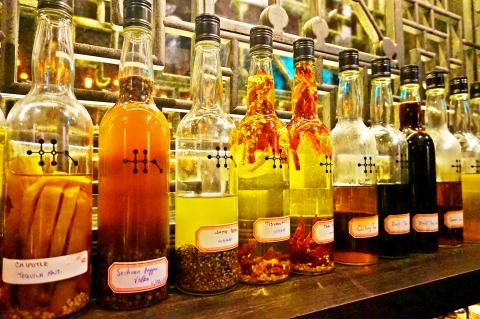
Photo: Dana Ter, Taipei Times
During the daytime, Huang is usually experimenting with new concoctions because, as he says, “the cost of playing around is negligible.”
But it’s not as easy as it seems. When I ask for a recipe to whip up my own cocktail from home, Gueroult looks at me as if I’m mad.
“To bartend, you need a bar,” Gueroult says.
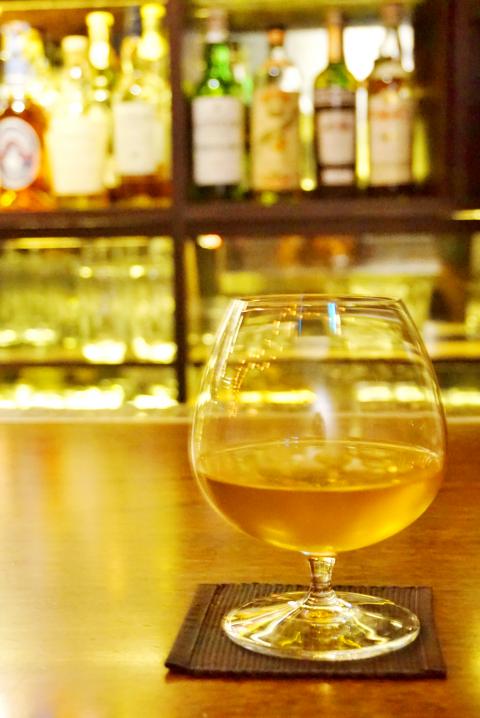
Photo: Dana Ter, Taipei Times
Infusions are tricky — not so much in the preparation, as that simply requires a lot of patience waiting for weeks for the ingredients to sink in to the alcohol — but more so in getting the balance of flavors right.
“Infusions are active and living, so you have to know when to kill them,” Huang says.
Despite the detailed craftsmanship that goes into making each cocktail, the founders insist that they’re not trying to be fancy. R&D isn’t the type of place to go if you’re looking to get intoxicated fast, but neither is it a place to put up airs. Rather, it’s about enjoying the flavors in the drinks — which can range from a mocktail to a smoky scotch.
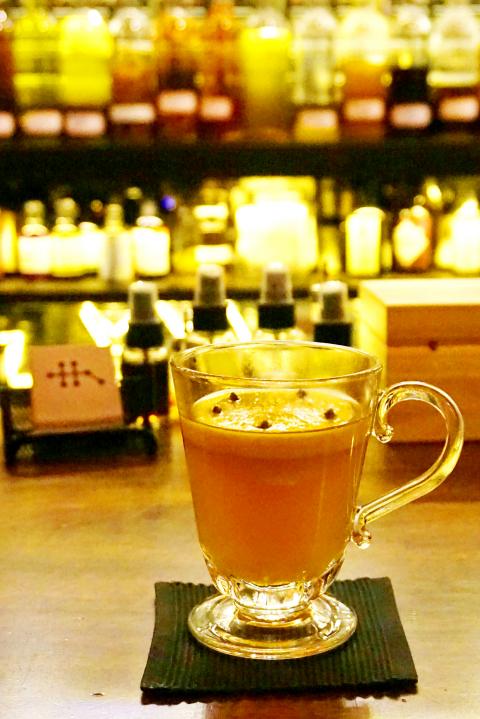
Photo: Dana Ter, Taipei Times
In fact, Gueroult sees the bar as being part of the recent healthy eating/farm-to-table movement, which has recently expanded to encompass alcohol.
“It’s not to say that alcohol is healthy,” Gueroult says. “But it’s more about appreciating the craft, as well as the quality of the drink.”
He adds that he’s hesitant to give their cocktails fancy names or to embellish them with garnishing since bartending to him is a craft, not an art.
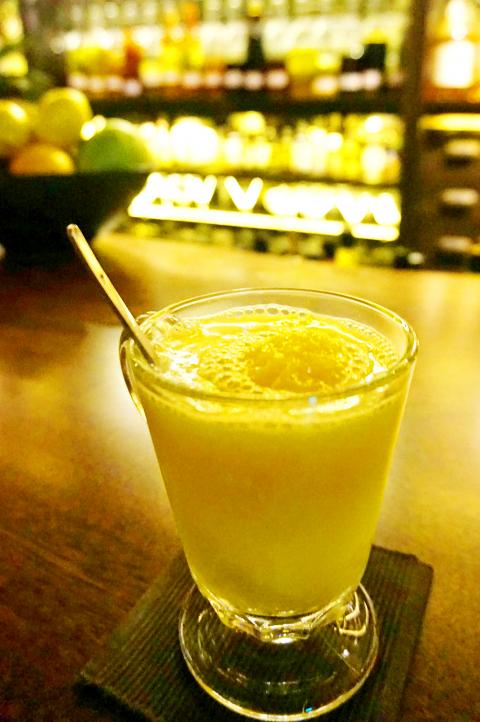
Photo: Dana Ter, Taipei Times
Huang thinks it’s because of their philosophy that the bar tends to attract a crowd closer to middle age — notably patrons in their 30s and 40s, although they do see some fellow jetsetters in their 20s.
“If you’ve traveled, you have to add 10 years to your age,” Huang says.
Although, looking around at the infusions and bitters resting atop Chinese medicine cabinets, while taking in a whiff of whiskey, R&D seems timeless at the very least.
TOP PICKS
Mango Agogo
This mango-rum infusion topped with a mango sorbet and a dollop of mango syrup is thirst-quenching and not too strong, making it an ideal summer drink.
Aaron’s Gambit
Aaron’s gambit is a drink for heavy Scotch drinkers. Made with a smoke gun technique, and consisting of a mixture of Talisker, an Oban 14-year-old whiskey, and a Dry Curacao, it has a smoky texture with a hint of hickory wood.
Burning Cane
The burning cane is made out of vanilla liquor, cinnamon, honey, bitters and rum which is heated at 57°C using a flaming blue blazer technique. While its warm and heavy taste gives the burning cane a festive flair, it’s also a suitable drink to mark the start of fall. With a hint of acidity, it pairs well with orange, chocolate or chestnut-based desserts. Another surprising quality that the burning cane has is that it’s soothing for your throat.
Taipei is a city that has positioned itself as being cheap and fast,but the revolution for craft drinks is taking wind and alcohol aficionados are thirsty for more. Thirsty in Taipei is a monthly column devoted to spotlighting chic, conceptual bars that aren’t your typical watering hole.

On April 26, The Lancet published a letter from two doctors at Taichung-based China Medical University Hospital (CMUH) warning that “Taiwan’s Health Care System is on the Brink of Collapse.” The authors said that “Years of policy inaction and mismanagement of resources have led to the National Health Insurance system operating under unsustainable conditions.” The pushback was immediate. Errors in the paper were quickly identified and publicized, to discredit the authors (the hospital apologized). CNA reported that CMUH said the letter described Taiwan in 2021 as having 62 nurses per 10,000 people, when the correct number was 78 nurses per 10,000

As we live longer, our risk of cognitive impairment is increasing. How can we delay the onset of symptoms? Do we have to give up every indulgence or can small changes make a difference? We asked neurologists for tips on how to keep our brains healthy for life. TAKE CARE OF YOUR HEALTH “All of the sensible things that apply to bodily health apply to brain health,” says Suzanne O’Sullivan, a consultant in neurology at the National Hospital for Neurology and Neurosurgery in London, and the author of The Age of Diagnosis. “When you’re 20, you can get away with absolute

May 5 to May 11 What started out as friction between Taiwanese students at Taichung First High School and a Japanese head cook escalated dramatically over the first two weeks of May 1927. It began on April 30 when the cook’s wife knew that lotus starch used in that night’s dinner had rat feces in it, but failed to inform staff until the meal was already prepared. The students believed that her silence was intentional, and filed a complaint. The school’s Japanese administrators sided with the cook’s family, dismissing the students as troublemakers and clamping down on their freedoms — with

As Donald Trump’s executive order in March led to the shuttering of Voice of America (VOA) — the global broadcaster whose roots date back to the fight against Nazi propaganda — he quickly attracted support from figures not used to aligning themselves with any US administration. Trump had ordered the US Agency for Global Media, the federal agency that funds VOA and other groups promoting independent journalism overseas, to be “eliminated to the maximum extent consistent with applicable law.” The decision suddenly halted programming in 49 languages to more than 425 million people. In Moscow, Margarita Simonyan, the hardline editor-in-chief of the